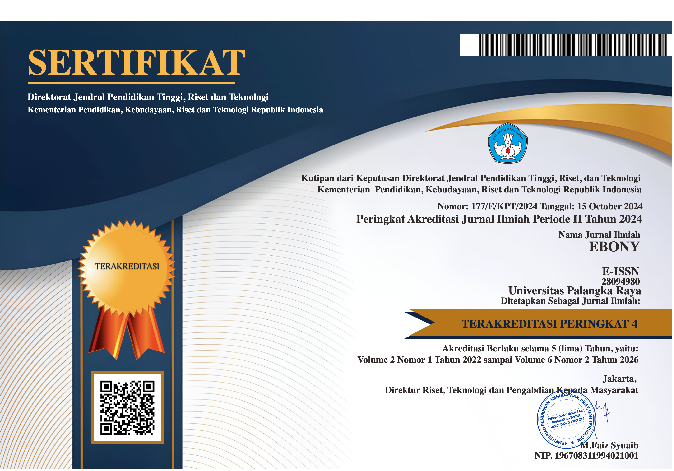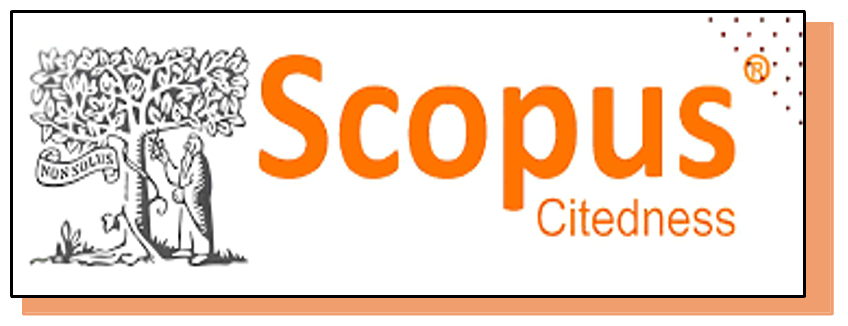Investigating the Use of Mobile-Assisted Language Learning (MALL) for Listening Instructions in SMAN 5 Tanjungpinang
DOI:
https://doi.org/10.37304/ebony.v5i1.18015Keywords:
English language teaching and learning, Listening Skills, MALL, Teaching MediaAbstract
Listening is essential for effective communication but often poses challenges in traditional teaching settings, where exposure to authentic materials is limited (Vandergrift & Goh, 2012). However, Mobile-Assisted Language Learning (MALL) provides mobile access to interactive audio content, enabling adaptive learning experiences (Burston, 2014) and continuous exposure to varied accents (Godwin-Jones, 2017). This study explores the implementation of MALL for listening instructions in SMAN 5 Tanjungpinang, focusing on the research questions: “Has SMAN 5 Tanjungpinang incorporated MALL into their teaching practices?” and “How does MALL contribute to improving SMAN 5 Tanjungpinang students' listening skills?” This qualitative research employs observation and semi-structured interviews to examine MALL's application in real classroom settings, aligning with the (Creswell, 2014) emphasis on context and utilizing thematic analysis to identify emerging patterns (Braun & Clarke, 2013). Findings reveal that while SMAN 5 Tanjungpinang has started incorporating MALL, there is significant potential to enhance its integration further and positively impact students' listening skills. These results highlight the importance of integrating mobile technology into educational curricula to enhance language learning outcomes.
Downloads
References
Braun, V., and Clarke, V. (2013). Successful Qualitative Research: A Practical Guide for Beginners. SAGE Publications.
Brown, H. D., and Lee, H. (2015). Teaching by Principles: An Interactive Approach to Language Pedagogy. Pearson Education.
Burston, J. (2014). MALL: The pedagogical challenges. Computer Assisted Language Learning, 27(4), 344–357. https://doi.org/10.1080/09588221.2014.914539
Cohen, L., Manion, L., and Morrison, K. (2018). Research Methods in Education. London: Routledge.
Creswell, J. W. (2014). Research Design: Qualitative, Quantitative, and Mixed Methods Approaches. SAGE Publications.
Godwin-Jones, R. (2017). Smartphones and language learning. Language Learning and Technology, 21(2), 3–17. https://dx.doi.org/10125/44607
Goh, C.C.M., and Vandergrift, L. (2012). Teaching and learning second language listening: Metacognition in action (1st ed.). Routledge. https://doi.org/10.4324/9780203843376
Hamid, et al. (2024). The effect of the use of mobile learning applications on students’ listening skills. Journal of Pedagogi, 1(5), 99-108. https://doi.org/10.62872/78841557
Hasan, M., and Islam, A. B. M. S. (2020). The effectiveness of mobile assisted language learning (MALL) on ESL listening skill. NOBEL: Journal of Literature and Language Teaching, 11(2), 188-202. https://doi.org/10.15642/NOBEL.2020.11.2.188-202
Hockly, N. (2013). Mobile learning. ELT Journal, 67(1), 80–84. https://doi.org/10.1093/elt/ccs064
Indriani, K. S. (2022). A need analysis of EFL learning at elementary school: A case study. Jurnal Basicedu, 6(6), 9850–9863.https://doi.org/10.31004/basicedu.v6i6.3870
Indrianty, S., and Kemala, Z. (2019). Listening strategies used by the students in improving listening skill (A case study at STIEPAR Language Center). Jurnal SORA, 2(1), 9–21.
Karakaya, K. and Bozkurt, A. (2022). Mobile-assisted language learning (MALL) research trends and patterns through bibliometric analysis: Empowering language learners through ubiquitous educational technologies. System, 110. https://doi.org/10.1016/j.system.2022.102925.
Klimova, B. (2019). Impact of mobile learning on students’ achievement results. Education Sciences, 9(2), 90. https://doi.org/10.3390/educsci9020090
Kukulska-Hulme, A., and Viberg, O. (2018). Mobile collaborative language learning: state of the art. British Journal of Educational Technology, 49(2), 207-218. https://doi.org/10.1111/bjet.12580
Leavy, P. (2017). Research Design: Quantitative, Qualitative, Mixed Methods, Arts-Based, and Community-Based Participatory Research Approaches. New York: Guilford Publications.
Nor, H. (2014). The techniques in teaching listening skill. Journal on English as a Foreign Language, 4(1), 41–51. https://doi.org/10.23971/jefl.v4i1.74
Rachman, A., Taswin, M.Z., Agustina, S., Zulfa, I., Manuhutu, A. (2023). Exploring the potential of mobile-assisted language learning (MALL) applications in developing english vocabulary skills. Journal on Education, 06(01), 4467–4474. https://doi.org/10.31004/joe.v6i1.3590
Safira, I., Rahim, A., and Palangi, P. I. (2022). Efektivitas augmented reality (AR) pada konsep pembelajaran IPA sekolah dasar. Klasikal: Journal of Education, Language Teaching and Science, 4(3), 685–692. https://doi.org/10.52208/klasikal.v4i3.414
Sepyanda, M., Deswarni, D., and Ardi, H. (2023). Mobile Assisted Language Learning (MALL): Exploring the students’ experience on listening activities. Lectura: Jurnal Pendidikan, 14(1), 60–71. https://doi.org/10.31849/lectura.v14i1.11943
Downloads
Published
How to Cite
Issue
Section
License
Copyright (c) 2025 Zidan Dwi Khalfani Kareem, Vebiyola Sihombing, Santo Andika Jaya, Sarah Stefani Simbolon, Dhipo Dzaki Aryuda, Erwin Pohan

This work is licensed under a Creative Commons Attribution 4.0 International License.











